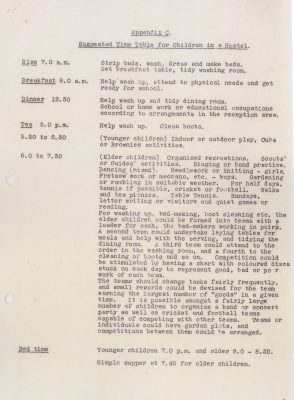Timetable of activities for children in a hostel
Reference: BRO/794/92/4
Suggested age groups: KS2, KS3, KS4, Lifelong Learners
Subject areas: WW2
CONTEXT
Not all children were given a place to stay with a family as soon as they stepped off the train. In Berwick these plans were made for children who didn’t have a host family straight away.
Children were divided into “younger” and “elder” children. The “elder” children were expected to help organise the chores, including bedmaking, washing up, tidying and cleaning boots.
The after-school activities were also divided up according to age, but also between boys and girls. Girls were expected to do needlework and knitting, while boys did fretsaw work (cutting wood or metal with a fine saw) or meccano (a toy made up of metal strips that could be screwed together to build models).
ACTIVITIES
ACTIVITY 1
Background
Not all children were given a place to stay with a family as soon as they stepped off the train. In Berwick these plans were made for children who didn’t have a host family straight away.
Children were divided into “younger” and “elder” children. The “elder” children were expected to help organise the chores, including bedmaking, washing up, tidying and cleaning boots.
SEE
See: Where did children who didn’t have a host family straight away go?
See: How were the children in the hostel divided?
See: What were the elder children suggested to do in teams?
See: What time did the children have to wake up?
See: What did the children have to do once they had woken up?
See: What time did the children have their meals?
See: What did the children do between meals?
See: What time did the children go to bed?
THINK
Think: How old do you think the younger and elder groups were?
Think: How do you think the children felt about the hostel timetable?
Think: How different do you think the hostel timetable would have been to how the children spent their time at home?
Think: How long do you think children would have stayed in the hostel before being placed with a. host family?
Think: How do you think the children felt about being placed in the hostel rather than with a host family?
Think: Why might the children’s chores have been turned into a team competition?
DO
Do: Imagine you are one of the children staying in the hostel. Write a diary entry about a day spent at the hostel.
Do: In pairs, script a conversation between two evacuees: one who is staying at the hostel and one who has been placed with a host family. Think about how their experiences may have differed and how they each might have felt about it.
Do: Look at the V&A’s 1940s knitting patterns. Have a go at knitting one of the items.
Do: What types of dance were popular during the 1940s? Can you have a go at trying some of them? (Note – resource link to BBC instructional Lindy Hop video).
Do: Research fretwork and fretwork patterns. Can you come up with your own design? Can you make your design? This could be done using paper and scissors if there is no access to wood/metal and saws.
Do: What types of food might the children have had at their tea picnic? Use the recipes from the 1940s Experiment website to make sausage rolls and scones and have a tea picnic.
Do: Divide into teams and have a go at completing some of the chores that the elder children were expected to do. See who can collect the most “good” coloured discs.
Note: These activities could be combined together as part of an Evacuee Day or similar event.
Resources
https://www.iwm.org.uk/history/the-evacuated-children-of-the-second-world-war
https://www.youtube.com/watch?v=ZPs8hbksOg8
https://www.bbc.co.uk/teach/school-radio/history-ks2-world-war-2-clips-ww2-evacuation-index/zvs3scw
https://www.vam.ac.uk/articles/1940s-knitting-patterns
https://www.vam.ac.uk/moc/collections/must-toys-1940s/
http://www.woodworkersworkshop.com/resources/index.php?search=FREE%20FRETWORK%20PATTERNS
https://www.bbc.co.uk/programmes/p00wgjmy
ACTIVITY 2
Background
Not all children were given a place to stay with a family as soon as they stepped off the train. In Berwick these plans were made for children who didn’t have a host family straight away.
SEE
See: Why did the children stay at the hostel after being evacuated?
See: Where was the hostel?
See: How did the evacuated children travel?
THINK
Think: Why were children evacuated during the Second World War?
Think: Who else, other than children, were evacuated during the Second World War?
Think: What types of areas were people evacuated from?
Think: What types of areas were people evacuated to?
Think: Why was there a second wave of evacuations?
DO
Do: Do you live in an area that people would have been evacuated to or from? Take a survey of the people around you to find out the most popular answer. Plot the answers on a bar chart.
Do: Can you find evidence online of people being evacuated to or from your area?
Do: Look at the Imperial War Museum’s evacuation posters. Design a poster to encourage parents to evacuate their children.
Resources
https://www.chroniclelive.co.uk/news/history/north-east-memories-day-world-11816858
https://www.iwm.org.uk/history/the-evacuated-children-of-the-second-world-war
https://www.nationalarchives.gov.uk/help-with-your-research/research-guides/evacuees/
https://www.thehistorypress.co.uk/articles/the-evacuation-of-children-during-the-second-world-war/
OTHER ONLINE RESOURCES
Imperial War Museum website, page about child evacuation: https://www.iwm.org.uk/history/the-evacuated-children-of-the-second-world-war
You Tube website, British Pathe film of children being evacuated: https://www.youtube.com/watch?v=ZPs8hbksOg8
BBC Teach website, includes radio report of evacuation and interviews with children and host families: https://www.bbc.co.uk/teach/school-radio/history-ks2-world-war-2-clips-ww2-evacuation-index/zvs3scw


